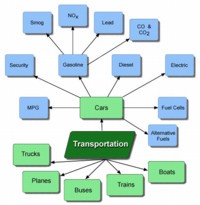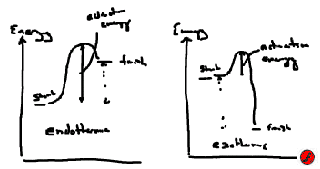 |
|
I am not old! At least I do not consider myself to be "old." As a lover of technology I have at times lamented colleagues who are trapped in the "walk and chalk" approach to teaching and learning. There have been so many "improvements" to try…overheads, PowerPoint, Web pages with automated quizzing, etc. I have-through my genesis from a student to an educator, to a life long learner and a teacher and learner used all these delivery approaches. Believing (perhaps foolishly) that each approach has been an incremental improvement, I now spend much of my time teaching an online version of my EGEE 101 "Energy and the Environment" course to about 300 students each semester. The class is (I believe) unique at University Park. You can take the class as a resident student (with my colleagues), as a Web-based course, or as a hybrid approach that blends the two delivery methods.
In the online course, I utilize color imagery, movies, audio, interactive components (such as dynamic images), crossword puzzles, humor, a personal "presence" via my writings and images, etc. My goal was to produce a multimedia rich learning experience that would promote learning though enhancing student thought and student reflection.
[See
a sample lesson.]
 |
 |
 |
 |
Link to the class overview |
Link to a movie example |
Crossword example |
Dynamic Image example |
But when I teach the hybrid version, I refuse to turn on the computer in the classroom! Instead I stand with chalk in hand (I am lucky enough to teach in a room that still has chalk!) ready to engage in academic "battle." As questions fly, so does the chalk dust! At the finale the chalkboard contains imagery that alone makes no sense.

An image of the blackboard in 012 Walker after an eclectic morning class. Looking at this it is a wonder the students learn anything! I would like to note that the hybrid class has full access to the online material.
Rather it was the process of creation - chalk line to chalk line with running commentary - that contains the seeds of knowledge and understanding. This is the approach to learning that our students are accustomed to and one that has, in the past, enabled them to succeed. It is also the easiest approach for the professor, especially in scientific and engineering courses. Capturing this experience and delivering it asynchronously, however, has been challenging. Streaming movies of the professor in class is one such approach, but it is time consuming to produce and costly. For the student: boredom, unless you are a master entertainer. Given all my technical abilities, fancy computers, advanced software, and a desire to better facilitate the learning process, I still can't beat the "walk and chalk" approach. |
| |
.... Of Kings and Cryptic Handwriting
While in Nashville attending the American
Society of Engineering Educators national meeting in the summer of 2003, I attended a presentation
by Professor Thomas Miller of North Carolina State University.
Tom and his students
had generated
software that utilized electronic writing tablets to produce voice-annotated
drawings, saved as Macromedia Flash objects. They named the software "Belshazzar." Belshazzar
is a biblical term relating to Belshazzar the king of the Chaldeans.
While engaged in a great feast with his followers, wives, and concubines,
a hand
appeared and wrote in the plaster of the wall. Interestingly, no
one there, the wise men or soothsayers, could read the writing
(much like my own scrawl
perhaps?). Daniel (of lion fame) was brought in and read the "handwriting
on the wall" which chastised the King for his behavior. The king, unfortunately
for him, was slain that night, presumably because of his sins.
I expect the Belshazzar software will have a much brighter future!.
|
 Rembrandt. The Feast of Belshazzar. c. 1635. Oil on canvas. National Gallery, London, UK
Rembrandt. The Feast of Belshazzar. c. 1635. Oil on canvas. National Gallery, London, UK
|
Belshazzar circa 2003
 Tom generously shared a copy of Belshazzar with me and I purchased the required additional hardware (a specially-designed electronic writing tablet from Mi-Co). With the Belshazzar software installed on my computer, I simply connect the electronic writing tablet and microphone to my computer. Then I use the tablet's special sensor pen to write on paper that I've clipped to the tablet. The tablet's pen captures pen strokes while the microphone captures my voice. The software synchronizes the two, saving them as a small Flash file. As I refer to something I've already drawn, even the waving of the pen over the drawn object is captured and is represented as a dynamic red dot in the Flash file (like a virtual laser pointer). A couple of mouse clicks and the software generates a Web page and the Flash file and delivers it via FTP to a server that I've pre-designated. It is very easy to use! Tom generously shared a copy of Belshazzar with me and I purchased the required additional hardware (a specially-designed electronic writing tablet from Mi-Co). With the Belshazzar software installed on my computer, I simply connect the electronic writing tablet and microphone to my computer. Then I use the tablet's special sensor pen to write on paper that I've clipped to the tablet. The tablet's pen captures pen strokes while the microphone captures my voice. The software synchronizes the two, saving them as a small Flash file. As I refer to something I've already drawn, even the waving of the pen over the drawn object is captured and is represented as a dynamic red dot in the Flash file (like a virtual laser pointer). A couple of mouse clicks and the software generates a Web page and the Flash file and delivers it via FTP to a server that I've pre-designated. It is very easy to use!
Examples of some of our initial Belshazzar efforts can be viewed below by clicking on eitehr of the two screen captures. |

Endothermic vs. Exothermic (1 min. 53 sec.) |
|

Catalytic Converters Explained (2 min. 15 sec.) |
|
| |
|
As engineers, Tom and his colleagues at North Carolina State utilize this approach to "scaffold" their problem sets, drawing equations, electrical diagrams, and solving complex solutions. I have been impressed, to say the least, and excited for the potential of replacing wordy textual explanations of complex issues in my online course with the more streamlined Belshazzar approach. In essence, the joy of teaching "live" at the chalkboard can be easily captured and delivered asynchronously to my online learners. I have my chalk back! As my enthusiasm has spread, Tom has generously shared the software with the John A. Dutton e-Education Institute (College of EMS) fellows and staff. Additional tablets were purchased from Mi-Co at a very reasonable cost ($200 each for an 8.5" x 11" tablet). It is anticipated that a commercial variation of the software will soon be available.
With some in-house Flash know how and wizardry (essentially David Babb), Flash files will be adjusted and manipulated to enhance their aesthetic appeal and functionality.
So have we come full circle in online education? We continue to produce excellent graduates by utilizing a variety of teaching and learning approaches, and all effective approaches have had a role to play in meeting the needs and desires of the faculty and students. "Chalk," in electronic delivery or as a smeared layer of calcium carbonate upon a dark background, is a wonderful approach to teaching, provided the dynamics of the chalk-wielding maniac (in my case) at the board and the accompanying words of wisdom are effectively captured. What was once old is again new. At least in the case of this old dog who can indeed discover old tricks! |
|
 |

